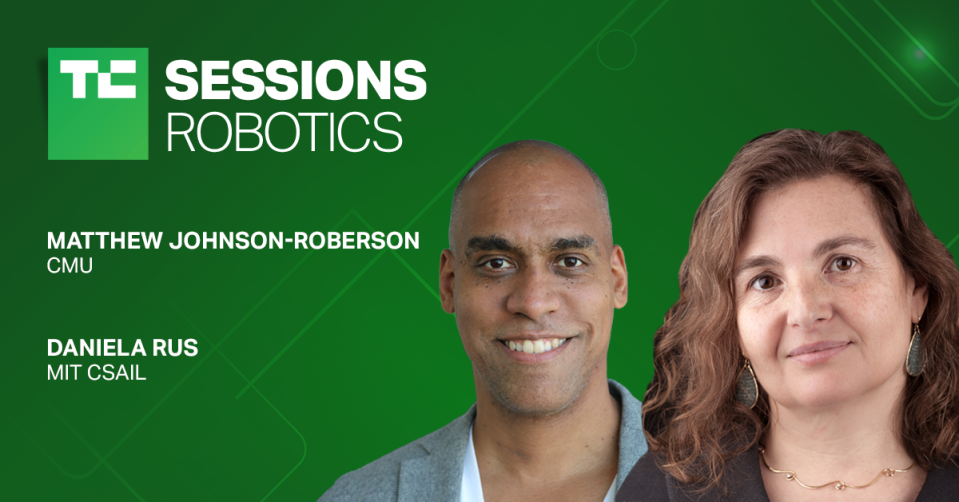CMU’s Matt Johnson-Roberson and MIT’s Daniela Rus will talk higher education at TC Sessions: Robotics 2022

Robotics technology, currently a $45.5 billion global market, has had an enormous impact on countless industries, including agtech, automotive, healthcare, labor, warehousing and logistics. Thanks to advances in AI, IoT and mobility tech — especially lidar sensors and computer vision — autonomous mobile robots (AMRs) open the door to a wider range of use cases and a market projection of $120.3 billion by 2026.
While the future of robotics looks bright, the direction it takes will ultimately be determined by the next generation of roboticists — and the academics who nurture and inspire their research and ideas.
That’s why we’re absolutely thrilled that Matthew Johnson-Roberson, the director of Carnegie Mellon University’s Robotics Institute and a professor in the School of Computer Science, and Daniela Rus, the director of MIT’s Computer Science and Artificial Intelligence Laboratory (CSAIL) and a professor of Electrical Engineering and Computer Science, will be joining us on stage at TC Sessions: Robotics 2022 on July 22 in Boston, Massachusetts.
We’ll touch on their respective areas of ongoing research, robotics breakthroughs and the role that colleges and universities play in accelerating the next generation of robotics startups. Both guests come to the stage with deep knowledge, experience and passion for robots and their ability to unlock human potential.
At Carnegie Mellon, Johnson-Roberson focuses on developing robotic systems capable of operating in complex, dynamic environments. He believes that robotic perception can potentially lead to the development of new robotic task domains.
Prior to assuming his current role, Johnson-Roberson was an associate professor of Engineering in the Department of Naval Architecture and Marine Engineering and the Department of Electrical Engineering and Computer Science at the University of Michigan. He co-directed the university’s Ford Center for Autonomous Vehicles (FCAV), and he founded and led the DROP (Deep Robot Optical Perception) Lab, which researches 3D reconstruction, segmentation, data mining and visualization. He also brings startup experience as a co-founder of Refraction AI.
Daniela Rus is the director of CSAIL at MIT where she also serves as the deputy dean of Research at the Schwarzman College of Computing and as director of the Toyota-CSAIL Joint Research Center. Rus' research interests include robotics, artificial intelligence and data science.
She envisions that the next 60 years will see robots shift from industrial to more human-centric environments to assist them with physical tasks — to the point where robots become as much a part of human life as smartphones are today.
Prior to her roles at MIT, Rus — a 2002 MacArthur Fellow, a fellow of ACM, AAAI and IEEE and a member of the National Academy of Engineering and the American Academy of Arts and Sciences — was a professor in the Computer Science Department at Dartmouth College.
Don’t miss this fascinating conversation with two of robotics’ leading research academics to learn about the next generation of roboticists and where they might take us.
TC Sessions: Robotics 2022 takes place in person on July 22 in Boston, Massachusetts. Buy your pass before Friday, April 29 at 11:59 p.m. (PDT) and get a second pass for free. Then get ready to join the robotics community’s top technologists, makers, thinkers, researchers and investors.
https://tcprotectedembed.com/protected-iframe/072b1a8ab938ef06a5bc33b9431d6c9c ( function() { var func = function() { var iframe = document.getElementById('wpcom-iframe-072b1a8ab938ef06a5bc33b9431d6c9c') if ( iframe ) { iframe.onload = function() { iframe.contentWindow.postMessage( { 'msg_type': 'poll_size', 'frame_id': 'wpcom-iframe-072b1a8ab938ef06a5bc33b9431d6c9c' }, "https:\/\/tcprotectedembed.com" ); } } // Autosize iframe var funcSizeResponse = function( e ) { var origin = document.createElement( 'a' ); origin.href = e.origin; // Verify message origin if ( 'tcprotectedembed.com' !== origin.host ) return; // Verify message is in a format we expect if ( 'object' !== typeof e.data || undefined === e.data.msg_type ) return; switch ( e.data.msg_type ) { case 'poll_size:response': var iframe = document.getElementById( e.data._request.frame_id ); if ( iframe && '' === iframe.width ) iframe.width = '100%'; if ( iframe && '' === iframe.height ) iframe.height = parseInt( e.data.height ); return; default: return; } } if ( 'function' === typeof window.addEventListener ) { window.addEventListener( 'message', funcSizeResponse, false ); } else if ( 'function' === typeof window.attachEvent ) { window.attachEvent( 'onmessage', funcSizeResponse ); } } if (document.readyState === 'complete') { func.apply(); /* compat for infinite scroll */ } else if ( document.addEventListener ) { document.addEventListener( 'DOMContentLoaded', func, false ); } else if ( document.attachEvent ) { document.attachEvent( 'onreadystatechange', func ); } } )();

 Yahoo Finance
Yahoo Finance 